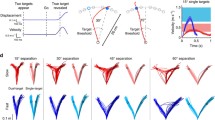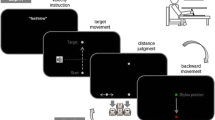Abstract
Two experiments investigated how persons with and without autism plan manual aiming movements when advance information is direct and when strategic planning is required. In Experiment 1 advance information about hand, direction, and/or movement amplitude was manipulated. Reaction times suggested both groups adopted a hierarchical pattern of movement planning. In Experiment 2, participants performed aiming movements to one of two targets that were the same or different size. Participants without autism varied the starting location in anticipation of specific target stimuli whereas participants with autism consistently selected the midpoint. Overall, individuals with autism used advance information to plan their movements when this information was direct. However, their performance became stereotyped when strategies were self-generated.





Similar content being viewed by others
Notes
Fitts law states that the time to execute an aiming movement is a function of the target amplitude and target width. Specifically MT = a + b log2ID where index of difficulty (ID) = 2 × target amplitude/target width.
Participants returned on another day to complete a similar experiment where the start location was predetermined. This protocol allowed detailed kinematic analysis of the movements. A paper reporting the results of this study is published in Motor Control (Glazebrook et al., 2006).
References
Anson, J. G., Hyland, B. I., Kotter, R., & Wickens, J. R. (2000). Parameter precuing and motor preparation. Motor Control, 4, 221–231.
Augustyn, J. S., & Rosenbaum, D. A. (2005). Metacognitive control of action: Preparation for aiming reflects knowledge of Fitts’ Law. Psychonomic Bulletin & Review, 12, 911–916.
Benhsain, K., Taillefer, A., & Ladouceur, R. (2003). Awareness of independence of events and erroneous perceptions while gambling. Addictive Behaviors, 29, 399–404.
Booth, R., Charlton, R., Hughes, C., & Happe, F. (2003). Disentangling weak coherence and executive dysfunction: Planning drawing in autism and attention-deficit/hyperactivity disorder. Philosophical Transactions of the Royal Society of London B, 358, 387–392.
Bryan, L. C., & Gast, D. L. (2000). Teaching on-task and on-schedule behaviors to high functioning children with autism via picture activity schedules. Journal of Autism and Developmental Disorders, 30, 553–567.
Chua, R., & Elliott, D. (1993). Visual regulation of manual aiming. Human Movement Science, 12, 365–401.
Elliott, D., Helsen, W. F., & Chua, R. (2001). A century later: Woodworth’s (1899) two-component model of goal-directed aiming. Psychological Bulletin, 127, 342–357.
Elliott, D., Roy, E. A., Goodman, D., Carson, R. G., Chua, R., & Maraj, B. K. V. (1993). Asymmetries in the preparation and control of manual aiming movements. Canadian Journal of Experimental Psychology, 47, 570–589.
Fitts, P. M. (1954). The information capacity of the human motor system in controlling the amplitude of movement. Journal of Experimental Psychology, 47, 381–391.
Fitts, P. M., & Peterson, J. R. (1964). Information capacity of discrete motor responses. Journal of Experimental Psychology, 67, 103–112.
Glazebrook, C. M., Elliott, D., & Lyons, J. L. (2006). A kinematic analysis of how young adults with and without autism plan and control goal-directed movements. Motor Control, 10, 244–264.
Goldstein, G., Johnson, C. R., & Minshew, N. J. (2001). Attentional processes in autism. Journal of Autism and Developmental Disorders, 31, 433–440.
Goodman, D., & Kelso, J. A. S. (1980). Are movements prepared in parts? Not under compatible (naturalized) conditions. Journal of Experimental Psychology: General, 109, 474–495.
Hallett, M., Lebiedowska, M. K., Thomas, S. L., Stanhope, S. J., Denckla, M. B., & Rumsey, J. (1993). Locomotion of autism adults. Archives of Neurology, 50, 1304–1308.
Hill, E. L. (2004). Evaluating the theory of executive dysfunction in autism. Developmental Review, 24, 189–233.
Hughes, C. (1996). Brief report: Planning problems in autism at the level of motor control. Journal of Autism and Developmental Disorders, 26, 99–106.
Klein, R. M. (2000). Inhibition of return. Trends in Cognitive Sciences, 4, 138–147.
Leary, M. R., & Hill, D. A. (1996). Moving on: Autism and movement disturbance. Mental Retardation, 34, 39–53.
Mari, M., Castiello, U., Marks, D., Marraffa, C., & Prior, M. (2003). The reach-to-grasp movement in children with autism spectrum disorder. Philosophical Transactions of the Royal Society of London B, 358, 393–403.
Masterton, B. A., & Biederman, G. B. (1983). Proprioceptive versus visual control in autistic children. Journal of Autism and Developmental Disorders, 13, 141–152.
Miyahara, M., Tsujii, M., Hori, M., Nakanishi, K., Kageyama, H., & Sugiyama, T. (1997). Brief report: Motor incoordination in children with Asperger syndrome and learning disabilities. Journal of Autism and Developmental Disorders, 27, 595–603.
Mohagheighi, A. A., & Anson, J. G. (2002). Amplitude and target diameter in motor programming of discrete, rapid aimed movements: Fitts and Peterson (1964) and Klapp (1975) revisited. Acta Psychologica, 109, 113–136.
Plaisted, K., Swettenham, J., & Rees, L. (1999). Children with autism show local precedence in a divided attention task and global precedence in a selective attention task. Journal of Child Psychology and Psychiatry, 40, 733–742.
Rinehart, N. J., Bradshaw, J. L., Brereton, A. V., & Tonge, B. J. (2001). Movement preparation in high-functioning autism and Asperger disorder: A serial choice reaction time task involving motor reprogramming. Journal of Autism and Developmental Disorders, 31, 79–88.
Rosenbaum, D. A. (1980). Human movement initiation: Specification of arm, direction, and extent. Journal of Experimental Psychology: General, 109, 444–474.
Rosenbaum, D. A., Marchak, F., Barnes, H. J., Vaughan, J., Slotta, J. D., & Jorgensen, M. J. (1990). Constraints for action selection: Overhand versus underhand grips. In M. Jeannerod (Ed), Attention and performance XIII (pp. 321–342). Hillsdale, NJ: Erlbaum.
Szatmari, P., Tuff, L., Allen, M., Finlayson, J., & Bartolucci, G. (1990). Asperger’s syndrome and autism: Neurocognitive aspects. Journal of the American Academy of Child and Adolescent Psychiatry, 29, 130–136.
Teitelbaum, P., Teitelbaum, O., Nye, J., Fryman, J., & Maurer, R. G. (1998). Movement analysis in infancy may be useful for early diagnosis of autism. Procedures of the National Academy of Science: Psychology, 95, 13982–13987.
Acknowledgments
This research was supported by Autism Ontario, the Natural Sciences and Engineering Research Council of Canada, and the Canada Research Chair Programme. We would like to thank John Moroz for his technical assistance, Victoria Dhillon and Melinda Wu for assisting with data collection. This research would not have been possible without the help of Robin Brennan, Dora Cheung, Rick Ludkin, the staff, and especially all of the participants from Woodview Manor in Hamilton, Ontario. Thank you!! A version of this manuscript was presented at the Canadian Society for Psychomotor Learning and Sport Psychology (Experiment 1) and the North American Society for Psychology of Sport and Physical Activity (Experiment 2).
Author information
Authors and Affiliations
Corresponding author
Rights and permissions
About this article
Cite this article
Glazebrook, C.M., Elliott, D. & Szatmari, P. How do Individuals with Autism Plan Their Movements?. J Autism Dev Disord 38, 114–126 (2008). https://doi.org/10.1007/s10803-007-0369-1
Received:
Accepted:
Published:
Issue Date:
DOI: https://doi.org/10.1007/s10803-007-0369-1




